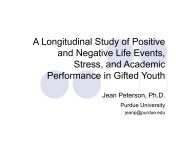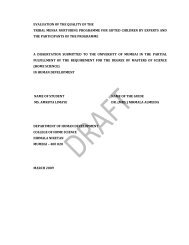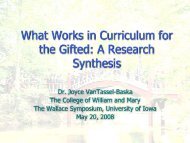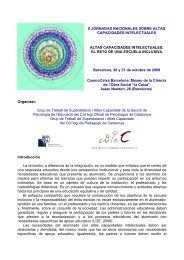Building gifts into talents: Overview of the DMGT - Templetonfellows ...
Building gifts into talents: Overview of the DMGT - Templetonfellows ...
Building gifts into talents: Overview of the DMGT - Templetonfellows ...
You also want an ePaper? Increase the reach of your titles
YUMPU automatically turns print PDFs into web optimized ePapers that Google loves.
About <strong>the</strong> chance factor<strong>DMGT</strong> overview 5Chance's placement within <strong>the</strong> <strong>DMGT</strong> has evolved considerably over <strong>the</strong> years. First introduced as one <strong>of</strong>five environmental sub-components, it became a qualifier <strong>of</strong> environmental factors. Chance represented <strong>the</strong>degree <strong>of</strong> control that talentees had over environmental influences. Its role broadened when it became clear that<strong>the</strong> problem <strong>of</strong> control also concerned o<strong>the</strong>r <strong>DMGT</strong> components.A famous psychologist in motivation, John William Atkinson, once stated that all humanaccomplishments could be ascribed to two crucial 'rolls <strong>of</strong> <strong>the</strong> dice' over which no individual exerts any personalcontrol: <strong>the</strong> accidents <strong>of</strong> birth and background. Indeed, we do not control <strong>the</strong> genetic endowment received atconception; yet, that genetic endowment affects both our natural abilities (<strong>the</strong> G component), our temperament,as well as o<strong>the</strong>r elements <strong>of</strong> <strong>the</strong> I component. Moreover, we do not control in which family and socialenvironment we are raised. These two impacts alone give a powerful role to chance in sowing <strong>the</strong> bases <strong>of</strong> aperson's talent development possibilities.III – UNDERNEATH THE <strong>DMGT</strong>As mentioned earlier, natural abilities are not innate. They do develop, yet have undeniable geneticunderpinnings. Now that <strong>the</strong> human genome has been decoded, researchers are trying (a) to pinpoint genesresponsible for various human abilities and o<strong>the</strong>r personal characteristics, and (b) to reconstruct <strong>the</strong> biologicalpath between <strong>the</strong>m and observable (phenotypic) characteristics. The <strong>DMGT</strong> represents a 'ground' level <strong>the</strong>ory <strong>of</strong>talent development. Underneath, we will find supporting biological and neurological structures. Theseunderground structures contribute to create large individual differences at 'ground' (behavioral) level.The <strong>DMGT</strong>'s underground can be metaphorically subdivided <strong>into</strong> three basements. At <strong>the</strong> bottom (B-3),we find genotypic structures and processes (e.g., DNA, RNA, protein production). The second basement (B-2)contains a large diversity <strong>of</strong> physiological and neurological processes (called endophenotypes) that control notonly a person's biological development from conception, but also ensure <strong>the</strong> proper functioning <strong>of</strong> body andbrain. The highest basement (B-1) includes anatomical structures (e.g., brain size, tallness, joint flexibility) thathave been associated with abilities and o<strong>the</strong>r personal characteristics. They are called exophenotypes.IV – PREVALENCE AND LEVELSHow many people are gifted and/or talented? The prevalence question is crucial in <strong>the</strong> case <strong>of</strong> normativeconstructs, which, just like giftedness and talent, target a small proportion <strong>of</strong> <strong>the</strong> whole population. Normativeconcepts include poverty, tallness, weight, most neurotic syndromes, and countless o<strong>the</strong>r concepts. Practicallyspeaking, adopting a threshold <strong>of</strong> 10% instead <strong>of</strong> 1%—a tenfold difference in estimated prevalence—has a hugeimpact on selection practices and educational provisions!The 'how many' question has no absolute answer; nowhere will we find a magical number thatautomatically separates those labeled gifted or talented from <strong>the</strong> rest <strong>of</strong> <strong>the</strong> population. The choice <strong>of</strong> anappropriate threshold requires that pr<strong>of</strong>essionals come to a consensus.In <strong>the</strong> <strong>DMGT</strong>, <strong>the</strong> threshold for both <strong>the</strong> giftedness and talent concepts is placed at <strong>the</strong> 90th percentile. Ino<strong>the</strong>r words, those who belong to <strong>the</strong> top 10% <strong>of</strong> <strong>the</strong> relevant reference group in terms <strong>of</strong> natural ability (forgiftedness) or achievement (for talent) deserve <strong>the</strong> relevant label. This generous choice <strong>of</strong> threshold iscounterbalanced by <strong>the</strong> recognition <strong>of</strong> levels or degrees <strong>of</strong> giftedness or talent. There are five hierarchicallystructured levels inspired by <strong>the</strong> metric system; each new level includes <strong>the</strong> top 10% (one decimal place) <strong>of</strong> <strong>the</strong>preceding level. This metric-based (MB) system <strong>of</strong> levels constitutes an intrinsic constituent <strong>of</strong> <strong>the</strong> <strong>DMGT</strong>.Within <strong>the</strong> top 10% <strong>of</strong> “mildly” gifted or talented persons, <strong>the</strong> <strong>DMGT</strong> proposes four progressively moreselective subgroups. They are labeled moderately (top 1%), highly (top 1:1,000), exceptionally (top 1:10,00),and extremely or pr<strong>of</strong>oundly (top 1:100,000).Note that <strong>the</strong> MB system <strong>of</strong> levels applies to every domain <strong>of</strong> giftedness and every field <strong>of</strong> talent. Becausegiftedness domains are not closely correlated, individuals gifted in one domain are not necessarily <strong>the</strong> same asthose gifted in ano<strong>the</strong>r. Consequently, <strong>the</strong> total number <strong>of</strong> gifted and talented individuals largely exceeds <strong>the</strong>10% value. Some studies indicate that it might well be two or three times larger.









